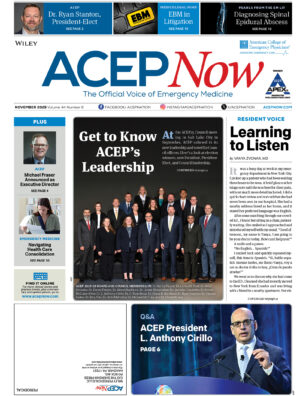BOSTON—Many may know Scott D. Weingart, MD, FACEP, as the chief of the Division of Emergency Critical Care at Stony Brook Hospital in New York City, and clinical associate professor of emergency medicine at Stony Brook Medicine. However, his coworkers often refer him to as “The Tube Stealer,” for advocating noninvasive positive pressure (NIPP) ventilation in specific patients. The advantages are clear, he said, including the elimination of crash intubations and reduced ICU stays.
Explore This Issue
ACEP15 Tuesday Daily NewsFor emergency physicians who wish to join Dr. Weingart’s camp, he suggested preparing for these patients by, first, acquiring a decent non-invasive or standard ventilator and learning to use it.
“We always get the crappiest ventilators in the ED,” he told a jam-packed room at ACEP15. “Fight to get a good one.” If that is impossible, he recommended investing in stand-alone continuous positive airway pressure (CPAP) devices that hook up to wall oxygen, at a cost of approximately $30 for a single-use package that includes a mask.
Although modern ventilators look complex, Dr. Weingart said that there are only a few dials that an emergency physician needs to know. First, set the mode to “spontaneous.” “This way, the patient has to inhale to get a breath,” he said. “Leave [the trigger] to whatever it’s already set to.”
The key is to understand the use of positive end expiratory pressure and type of exhalation. Inspiratory positive airway pressure (IPAP) fixes ventilation issues. Expiratory positive airway pressure (EPAP) fixes oxygenation problems.
“Don’t give IPAP if ventilation is fine. Don’t give EPAP if oxygenation is fine,” Dr. Weingart said, adding it’s important to remember that an increase in EPAP causes the tidal volume to fall.
He also said he believes that, in these situations, there is no difference between CPAP and bi-level positive airway pressure (BiPAP). The real question should be, how much expiratory pressure does the patient need?
With regard to patients in respiratory failure, there are generally two types—those with an oxygen issue and those with chronic issues, including those with chronic obstructive pulmonary disease (COPD), which are typically a ventilation problem.
“There is no better use of noninvasive ventilation than COPDers. This is the huge ‘win’ we have in the ED,” he said.
Check out today’s ACEP15 video that highlights Dr. Steingart’s session
Another type of patient who can benefit from NIPP are those suffering from sympathetic crashing acute pulmonary edema (SCAPE). Dr. Weingart said these patients present as pale, cold, and sweaty.
“If we don’t treat them immediately, they will die,” he said. He also noted that NIPP provides a secondary benefit of reducing afterload. “It gives the heart a nice little squeeze.”
Dr. Weingart also uses NIPP for patients in respiratory distress with DNR orders.
“It seems like an aggressive modality, but it’s actually comfort palliation,” he said. If the family wants to be with them, he exchanges the non-rebreather mask for a high-flow, nasal cannula.
According to Dr. Weingart, several patient populations benefit from the use of NIPP. Although he is known by his colleagues for stealing their tubes, he said, “That’s a good thing.”
Teresa McCallion is a freelance medical writer based in Washington State.
Pages: 1 2 | Multi-Page


No Responses to “ACEP15: “The Tube Stealer” Advocates in Favor of Non-Invasive Positive Pressure”